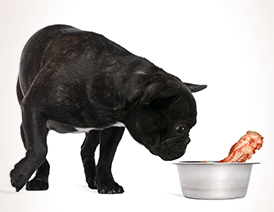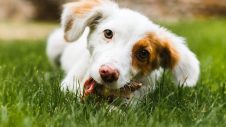 Are bones safe treats for dogs?
Are bones safe treats for dogs?
While many consider dogs and bones an inseparable pair, you should only give a dog a bone under certain circumstances. Avoid putting your pet at risk with these tips.
Bones do have dental and nutritional benefits, but giving dogs the wrong type of bone can be hazardous. Dr Josh Llinas from Greencross Vets Jindalee has the following advice for giving dogs bones. His rules are:
- bones should only be given to dogs under supervision, and they should never be left alone with them
- bones should never be given in small chunks as they could be swallowed
- cooked bones should never be given to dogs
- bones should be almost as big as your dog’s head
- never let a dog bury a bone, nor dig them up later on to eat
- frozen bones should never be given to dogs
‘It pays to be cautious and to supervise your dog while they eat the bone,’ says Dr Josh. ‘Don’t give your dog a bone before you walk out the door – that’s not what bones are for,’ he says. ‘Bones can help to clean teeth from a veterinary point of view. They do have a lot of nutrition in them, but if dogs are fed well-balanced dog food, treats for added nutrition aren’t necessary.’
Risks
The risks that go along with giving dogs bones include:
- Obstructions in the digestive system
- Foreign bodies getting stuck in the mouth, throat, oesophagus or stomach
- Cracking teeth
- Choking hazards
- Bacterial infection
- Constipation
The risks that go along with giving dogs bones include obstructions in the digestive system, foreign bodies getting stuck in teeth, cracking teeth, choking hazards, and bacterial infection.
Types of bones
‘Cooked bones are not digestible,’ says Dr Josh. ‘They also have a higher risk of splintering, and poking through abdominal organs like the stomach and intestines. If they happen to get all the way through they can also be very uncomfortable for the dog to get out the other end. Frozen bones get very hard and dogs are more likely to crack their teeth on them, and old or buried bones grow bacteria on them that can cause infection.’
While there are plenty of risks associated with bones, as long as dog owners are responsible with the way they give bones to their dog, there should be no problems.
‘The bone should be as big as the dog’s head, that way they can’t accidentally swallow it,’ says Dr Josh. ‘And don’t let them have it for too long – remove it fairly soon after they’ve had a good chew on it.’
Can I feed my dog leftover bones?
Leftover bones can be a great treat for dogs. However, if you must give your dog a bone then it should always be raw. If they are cooked, smoked, fried or steamed, this makes the bone very brittle and likely to splinter.
What bones can I give my dog?
Ideal bones for dogs are round bones with bulges or lumps at either end, like leg bones. Many other types of bones are easier for dogs to break with their bite, and are more likely to cause problems.
“I don’t bother with chicken necks or chicken wings,” says Dr Josh. “Not only do they have salmonella and E. coli, they are too soft to do any good.”
If you’re intent on feeding your dog chicken bones, make sure you only use parts like chicken wing tips or neck pieces – and always cut them up into small, flattened pieces.
“It’s good to get dogs used to having bones early on, but always under supervision. If you see any adverse effects, like diarrhoea or vomiting, your dog may not be a good candidate for having bones.”
Puppies, in particular, love to chew. There is a range of products that are safer and healthier than bones that will keep your dog entertained, maintain healthy teeth, and keep their jaw strong. These include flavoured synthetic bones and toys filled with dental-friendly treats.
For more information about what bones you can give dogs, and the associated risks, visit your local Greencross Vets.

 Greencross Vets
Greencross Vets 




